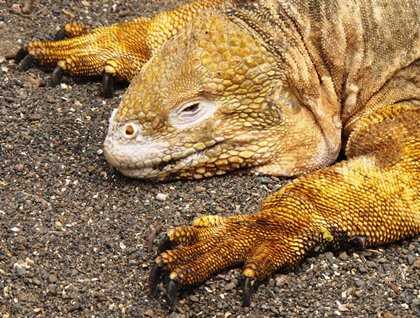Isabela is the largest of the Galapagos Islands. Today, we have the opportunity to explore its beautiful western coast. In the morning we visited Urbina Bay, which has been the scene of some recent volcanic activity. In 1954, about 1.5km2 of coastline was suddenly uplifted, leaving many marine creatures stranded and unable to return to sea. The uplift also revealed some massive coral heads, which by now, after so many decades, have already bleached under the equatorial sun. The vegetation has already covered much of this evidence, and new creatures have established themselves here. Urbina is now the home to a small population of land iguanas. We found several of them along the trail. It was fun to watch one of them making huge efforts to reach the fruit of the poison apple tree, a favorite food for them. Some giant tortoises have also moved into the vicinity, and today we were fortunate enough to see a few of them. They seemed a little lethargic, but it was still early in the morning. There were also many little land birds, which we recognized as Darwin finches. They were collecting little seeds and bugs while others were drinking the tiny droplets of water that the early morning mist had deposited on the leaves of the bushes and trees.
After a quick dip in the water we returned back onboard. We had to navigate further north in order to reach Tagus Cove, our site for the afternoon. We had several options for activities here, all of which were a lot of fun. The cove is quite protected and it has offered a safe anchorage to many visiting yachts and ships in the past. Some knew where to find a semi-permanent fresh water spring nearby, and tortoises used to be abundant so food was also available. The place definitely has a lot of history, and we could testify that by all of the graffiti left painted or carved on the walls of Tagus Cove by past visitors. Some of our guests decided to explore this stunning coast of tall cliffs from our kayaks, while others preferred to go snorkeling. Today may not have been the best visibility, but it was obvious that the place is full of fantastic creatures like Galapagos penguins and flightless cormorants. Later on, some decided to join the hike towards the summit of a small crater, from which some majestic views could be observed. It was a fast, gently sloping hike, but the colors of the afternoon and the surrounding landscapes were simply spectacular! For the non-hikers, there was an option of a Zodiac ride. Once again, we were fortunate to encounter various species that one can only find in this last paradise on earth, relatively untouched, that is the Galapagos Archipelago. We are sure, more wonders of this natural world await us tomorrow at Santiago Island.







